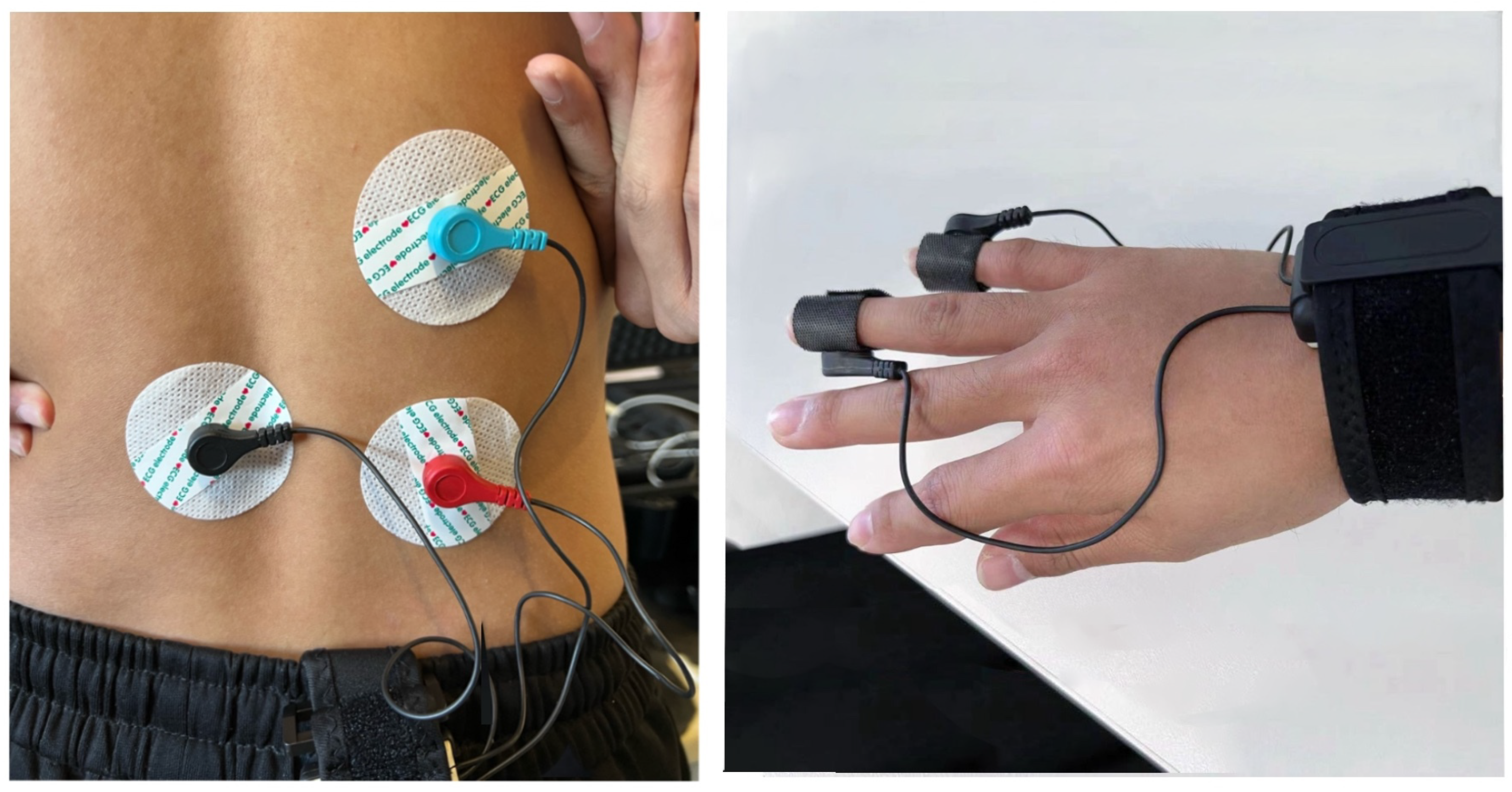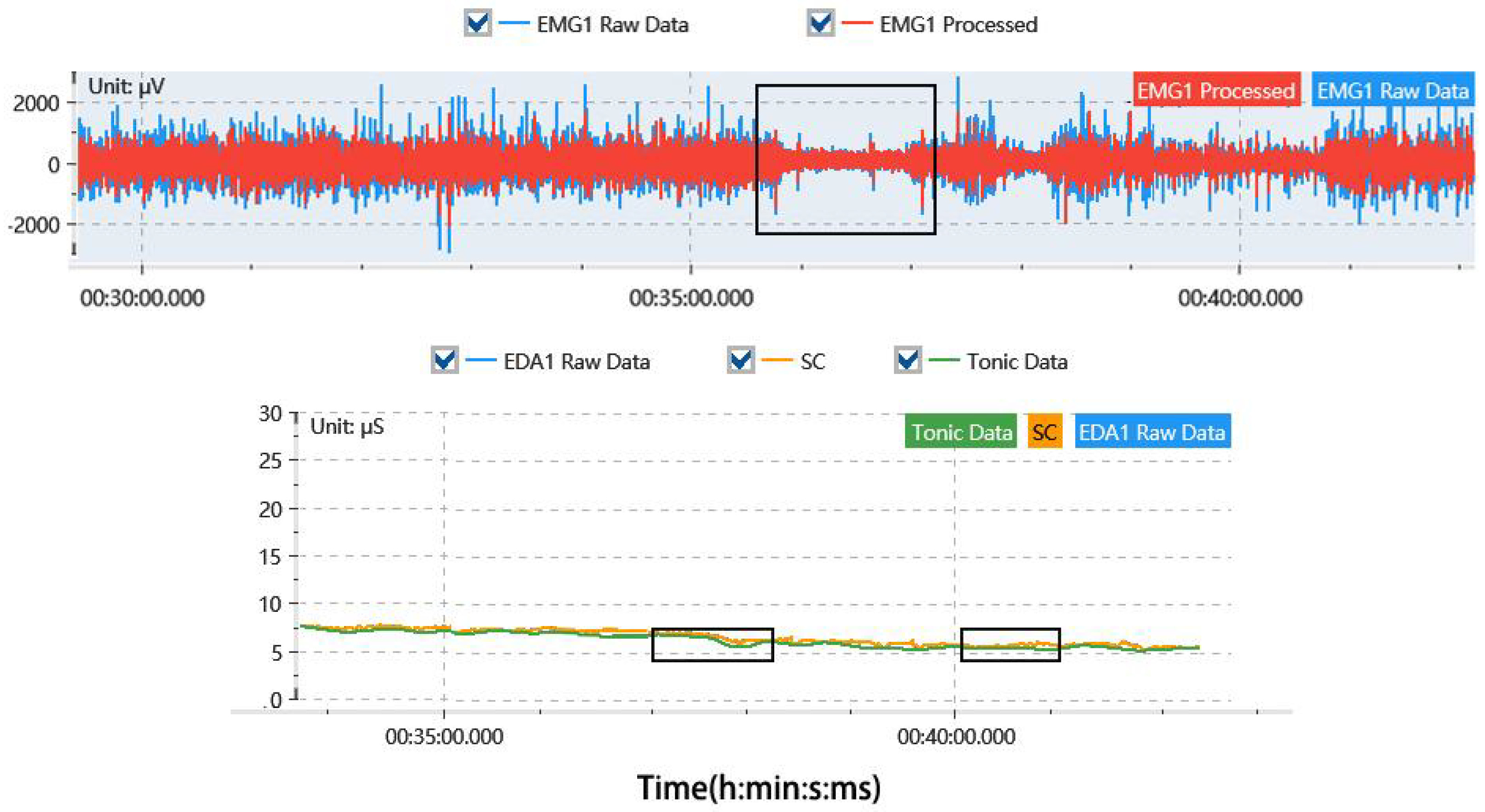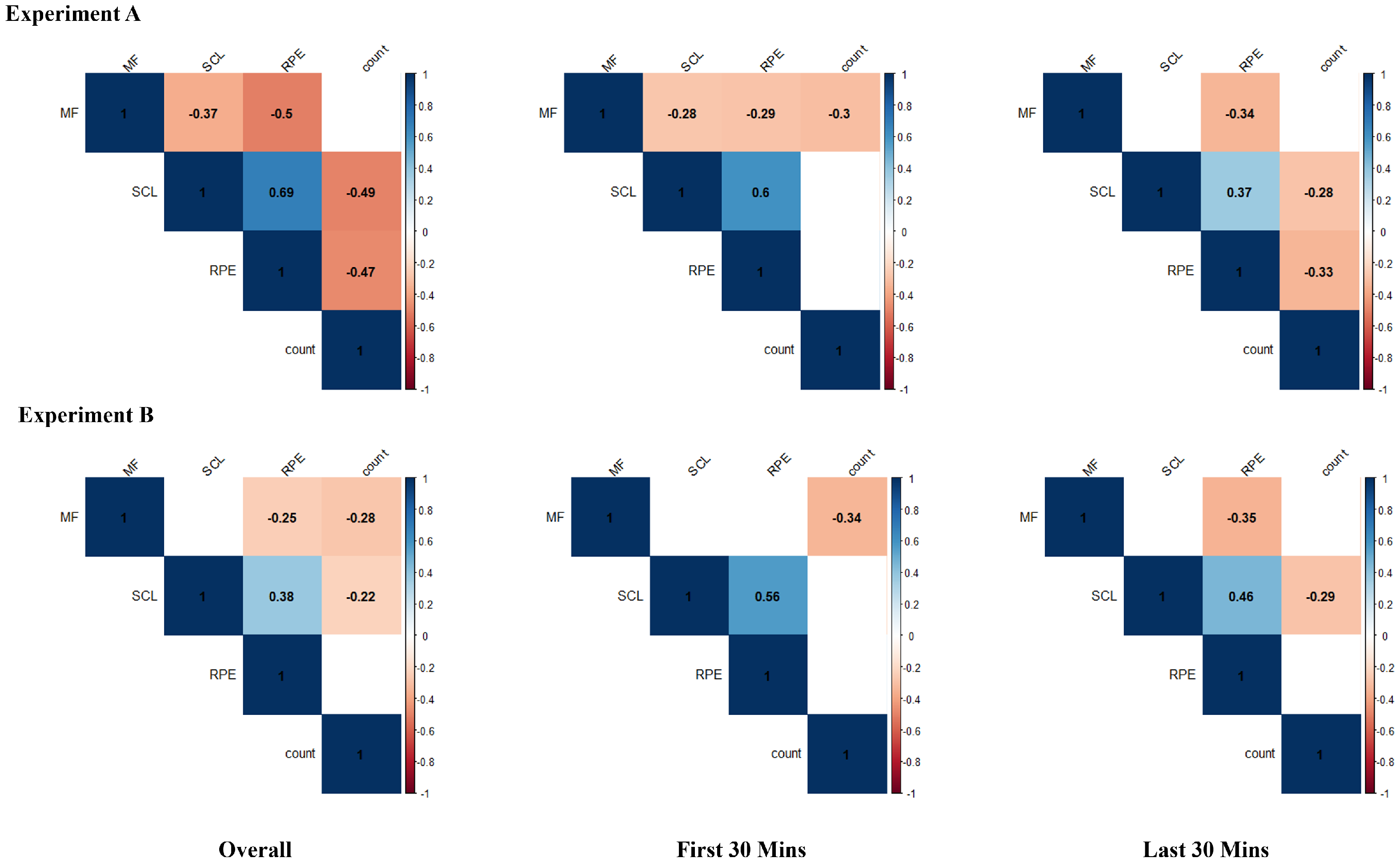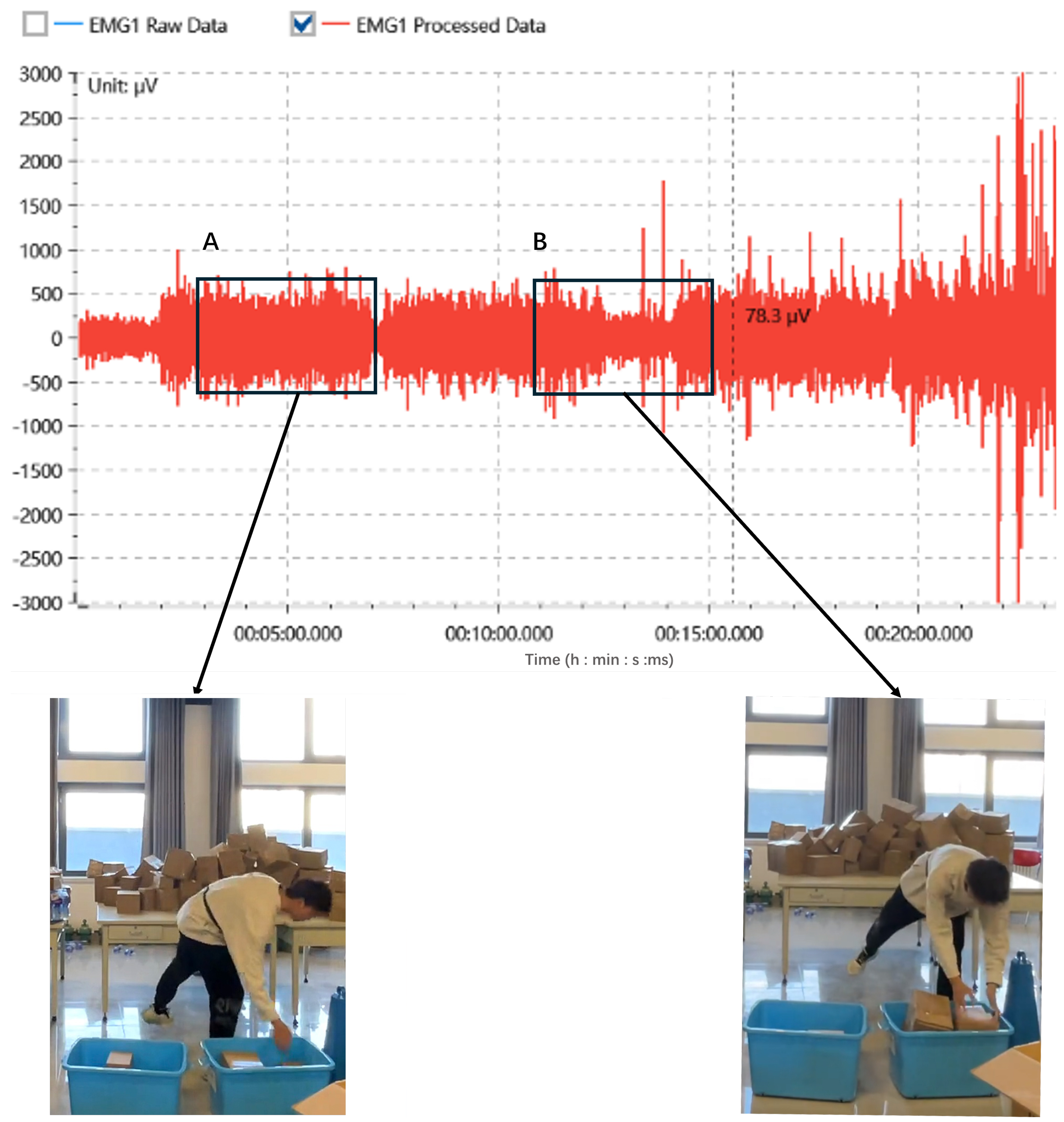The Impact of Physiological and Psychological Fatigue on Work Efficiency: A Case Study of Parcel Sorting Work
Abstract
:1. Introduction
2. Materials and Methods
2.1. Participants
2.2. Experiment Procedure
2.3. Assessment Tools
2.4. Physiological Measurements
2.5. Data Analysis
3. Results
3.1. Participant Descriptive
3.2. MF and SCL Difference Analysis
3.3. Analysis of Rest Periods
3.4. Analysis of Changes in Sorting Count
3.5. Panel Data Correlation Analysis
3.6. Video Analysis
4. Discussion
4.1. Overall Analysis of the Two Experiments
4.2. Analysis of Experiment A
4.3. Analysis of Experiment B
4.4. Subjective Fatigue Analysis
4.5. Rest Period Study
4.6. Limitations
5. Conclusions
Author Contributions
Funding
Institutional Review Board Statement
Informed Consent Statement
Data Availability Statement
Acknowledgments
Conflicts of Interest
References
- Lin, M. Psychological health correlation of express delivery workers’ occupational stress in the information logistics environment. Front. Psychol. 2022, 13, 975387. [Google Scholar] [CrossRef]
- Allen, D.G.; Lamb, G.D.; Westerblad, H. Skeletal Muscle Fatigue: Cellular Mechanisms. Physiol. Rev. 2008, 88, 287–332. [Google Scholar] [CrossRef] [PubMed]
- Liu, Y.; Lin, Z.; Yang, Z.; Li, H.; Shen, Y. Research Progress of Work Fatigue Detection Technology. In Proceedings of the 2020 IEEE 2nd International Conference on Civil Aviation Safety and Information Technology (ICCASIT), Weihai, China, 14–16 October 2020. [Google Scholar] [CrossRef]
- Qu, Y.; Zhao, N.; Zhang, H. Digital Twin Technology of Human–Machine Integration in Cross-Belt Sorting System. Chin. J. Mech. Eng. 2024, 37, 33. [Google Scholar] [CrossRef]
- Grandjean, E. Fatigue in industry. Occup. Environ. Med. 1979, 36, 175–186. [Google Scholar] [CrossRef] [PubMed]
- Mohanavelu, K.; Lamshe, R.; Poonguzhali, S.; Adalarasu, K.; Jagannath, M. Assessment of human fatigue during physical performance using physiological signals: A review. Biomed. Pharmacol. J. 2017, 10, 1887–1896. [Google Scholar] [CrossRef]
- Gawron, V.J.; French, J.; Funke, D. An overview of fatigue. In Stress, Workload, and Fatigue; CRC Press: Boca Raton, FL, USA, 2000; pp. 581–595. [Google Scholar] [CrossRef]
- Ament, W.; Verkerke, G.J. Exercise and fatigue. Sport. Med. 2009, 39, 389–422. [Google Scholar] [CrossRef]
- Yassi, A. Work-related musculoskeletal disorders. Curr. Opin. Rheumatol. 2000, 12, 124–130. [Google Scholar] [CrossRef]
- Wang, J.; Cao, Y.; Jin, X.; Maimaiti, N.; He, L.; Zhang, Z.; Wang, Z.; Zhang, W. Work-related musculoskeletal disorders and risk factors: A cross-sectional study among Chinese flight baggage handlers. In Proceedings of the 20th Congress of the International Ergonomics Association (IEA 2018), Florence, Italy, 26–30 August 2018; Volume III: Musculoskeletal Disorders 20. Springer: Cham, Switzerland, 2019; pp. 212–218. [Google Scholar] [CrossRef]
- Corbeil, P.; Plamondon, A.; Teasdale, N.; Handrigan, G. Biomechanical differences between obese and healthy-weight workers in manual materials handling. Proc. Hum. Factors Ergon. Soc. Annu. Meet. 2013, 57, 958–961. [Google Scholar] [CrossRef]
- van Dijk, F.J.; Swaen, G.M. Fatigue at work. Occup. Environ. Med. 2003, 60 (Suppl. 1), i1–i2. [Google Scholar] [CrossRef]
- Féasson, L.; Camdessanché, J.P.; El Mhandi, L.; Calmels, P.; Millet, G.Y. Fatigue and neuromuscular diseases. Ann. Réadapt. Méd. Phys. 2006, 49, 375–384. [Google Scholar] [CrossRef]
- Dennison, K.J.; Mullineaux, D.R.; Yates, J.W.; Abel, M.G. The effect of fatigue and training status on firefighter performance. J. Strength Cond. Res. 2012, 26, 1101–1109. [Google Scholar] [CrossRef] [PubMed]
- Allahyari, T.; Mortazavi, N.; Khalkhali, H.R.; Sanjari, M.A. Shoulder girdle muscle activity and fatigue in traditional and improved design carpet weaving workstations. Int. J. Occup. Med. Environ. Health 2015, 29, 345–354. [Google Scholar] [CrossRef] [PubMed]
- Zhang, Z.; Xiang, T.; Guo, H.; Ma, L.; Guan, Z.; Fang, Y. Impact of physical and mental fatigue on construction workers’ unsafe behavior based on physiological measurement. J. Safety Res. 2023, 85, 457–468. [Google Scholar] [CrossRef] [PubMed]
- Sun, H.; Jia, A. Study on the development process of apron controller’s work fatigue based on heart rate characteristics. Heliyon 2024, 10, e26296. [Google Scholar] [CrossRef] [PubMed]
- Van Cutsem, J.; Marcora, S.; De Pauw, K.; Bailey, S.; Meeusen, R.; Roelands, B. The effects of mental fatigue on physical performance: A systematic review. Sport. Med. 2017, 47, 1569–1588. [Google Scholar] [CrossRef]
- Mahmud, M.S.; Wang, H.; Fang, H. SensoRing: An integrated wearable system for continuous measurement of physiological biomarkers. In Proceedings of the 2018 IEEE International Conference on Communications (ICC), Kansas City, MO, USA, 20–24 May 2018; IEEE: Piscataway, NJ, USA, 2018; pp. 1–7. [Google Scholar] [CrossRef]
- Faber, L.G.; Maurits, N.M.; Lorist, M.M. Mental fatigue affects visual selective attention. PLoS ONE 2012, 7, e48073. [Google Scholar] [CrossRef]
- Duncan, M.J.; Fowler, N.; George, O.; Joyce, S.; Hankey, J. Mental fatigue negatively influences manual dexterity and anticipation timing but not repeated high-intensity exercise performance in trained adults. Res. Sport. Med. 2015, 23, 1–13. [Google Scholar] [CrossRef]
- Melo, H.; Nascimento, L.; De Mello, V.; Takase, E. Influência do ritmo Alfa (8–12 Hz) no tempo de reação em uma tarefa de controle inibitório. Rev. Neuropsicol. Latinoam. 2017, 9, 33–43. [Google Scholar]
- Van Der Linden, D.; Eling, P. Mental fatigue disturbs local processing more than global processing. Psychol. Res. 2006, 70, 395–402. [Google Scholar] [CrossRef]
- Jackson, C. The Chalder fatigue scale (CFQ 11). Occup. Med. 2015, 65, 86. [Google Scholar] [CrossRef]
- Kaida, K.; Takahashi, M.; Åkerstedt, T.; Nakata, A.; Otsuka, Y.; Haratani, T.; Fukasawa, K. Validation of the Karolinska sleepiness scale against performance and EEG variables. Clin. Neurophysiol. 2006, 117, 1574–1581. [Google Scholar] [CrossRef] [PubMed]
- Kim, G.; Walden, T.; Harris, V.; Karrass, J.; Catron, T. Positive emotion, negative emotion, and emotion control in the externalizing problems of school-aged children. Child Psychiatry Hum. Dev. 2007, 37, 221–239. [Google Scholar] [CrossRef] [PubMed]
- Valko, P.O.; Bassetti, C.L.; Bloch, K.E.; Held, U.; Baumann, C.R. Validation of the fatigue severity scale in a Swiss cohort. Sleep 2008, 31, 1601–1607. [Google Scholar] [CrossRef] [PubMed]
- Helton, W.S.; Russell, P.N. Rest is still best: The role of the qualitative and quantitative load of interruptions on vigilance. Human Factors 2017, 59, 91–100. [Google Scholar] [CrossRef] [PubMed]
- Tucker, P.; Folkard, S.; Macdonald, I. Rest breaks and accident risk. Lancet 2003, 361, 680. [Google Scholar] [CrossRef]
- Fischetti, F.; Pepe, I.; Greco, G.; Ranieri, M.; Poli, L.; Cataldi, S.; Vimercati, L. Ten-Minute Physical Activity Breaks Improve Attention and Executive Functions in Healthcare Workers. J. Funct. Morphol. Kinesiol. 2024, 9, 102. [Google Scholar] [CrossRef]
- Boksem, M.A.; Meijman, T.F.; Lorist, M.M. Effects of mental fatigue on attention: An ERP study. Cogn. Brain Res. 2005, 25, 107–116. [Google Scholar] [CrossRef]
- Silvetti, A.; Ranavolo, A.; Gravino, V.; Forzano, F.; Iavicoli, S.; Chini, G.; Draicchio, F. Kinematic and electromyographic assessment of upper limb repetitive movements in an artisanal pastry workshop. Procedia Manuf. 2015, 3, 4315–4321. [Google Scholar] [CrossRef]
- Thompson, D.; Mackenzie, I.G.; Leuthold, H.; Filik, R. Emotional responses to irony and emoticons in written language: Evidence from EDA and facial EMG. Psychophysiology 2016, 53, 1054–1062. [Google Scholar] [CrossRef]
- Xu, Y.; Hübener, I.; Seipp, A.K.; Ohly, S.; David, K. From the lab to the real-world: An investigation on the influence of human movement on Emotion Recognition using physiological signals. In Proceedings of the 2017 IEEE International Conference on Pervasive Computing and Communications Workshops (PerCom Workshops), Kona, HI, USA, 13–17 March 2017; IEEE: Piscataway, NJ, USA, 2017; pp. 345–350. [Google Scholar] [CrossRef]
- Horvers, A.; Tombeng, N.; Bosse, T.; Lazonder, A.W.; Molenaar, I. Detecting emotions through electrodermal activity in learning contexts: A systematic review. Sensors 2021, 21, 7869. [Google Scholar] [CrossRef]
- Correa, M.; Projetti, M.; Siegler, I.A.; Vignais, N. Mechanomyographic analysis for muscle activity assessment during a load-lifting task. Sensors 2023, 23, 7969. [Google Scholar] [CrossRef] [PubMed]
- Fu, J.; Ma, L.; Tsao, L.; Zhang, Z. Continuous measurement of muscle fatigue using wearable sensors during light manual operations. In Digital Human Modeling and Applications in Health, Safety, Ergonomics and Risk Management. Human Body and Motion, Proceedings of the 10th International Conference, DHM 2019, Held as Part of the 21st HCI International Conference, HCII 2019, Orlando, FL, USA, 26–31 July 2019; Proceedings, Part I 21; Springer: Cham, Switzerland, 2019; pp. 266–277. [Google Scholar] [CrossRef]
- Ritchie, C. Rating of perceived exertion (RPE). J. Physiother. 2012, 58, 62. [Google Scholar] [CrossRef] [PubMed]
- Pop-Jordanova, N.; Pop-Jordanov, J. Electrodermal activity and stress assessment. Prilozi 2020, 41, 5–15. [Google Scholar] [CrossRef]
- Watson, D.; Clark, L.A.; Tellegen, A. Development and validation of brief measures of positive and negative affect: The PANAS scales. J. Personal. Soc. Psychol. 1988, 54, 1063. [Google Scholar] [CrossRef] [PubMed]
- Viitasalo, J.H.; Komi, P.V. Signal characteristics of EMG during fatigue. Eur. J. Appl. Physiol. Occup. Physiol. 1977, 37, 111–121. [Google Scholar] [CrossRef] [PubMed]
- Phinyomark, A.; Thongpanja, S.; Hu, H.; Phukpattaranont, P.; Limsakul, C. The usefulness of mean and median frequencies in electromyography analysis. Comput. Intell. Electromyogr. Anal.-A Perspect. Curr. Appl. Future Challenges 2012, 23, 195–220. [Google Scholar] [CrossRef]
- Boucsein, W. Electrodermal Activity; Springer Science & Business Media: New York, NY, USA, 2012. [Google Scholar] [CrossRef]
- Posada-Quintero, H.F.; Chon, K.H. Innovations in electrodermal activity data collection and signal processing: A systematic review. Sensors 2020, 20, 479. [Google Scholar] [CrossRef]
- Freeman, E.; Heathcote, A.; Chalmers, K.; Hockley, W. Item effects in recognition memory for words. J. Mem. Lang. 2010, 62, 1–18. [Google Scholar] [CrossRef]
- Barr, D.J.; Levy, R.; Scheepers, C.; Tily, H.J. Random effects structure for confirmatory hypothesis testing: Keep it maximal. J. Mem. Lang. 2013, 68, 255–278. [Google Scholar] [CrossRef]
- Lenth, R.V. Emmeans: Estimated Marginal Means, Aka Least-Squares Means, 2024. R Package Version 1.10.2.090004. Available online: https://rvlenth.github.io/emmeans/ (accessed on 13 May 2024).
- Hsiao, C. Panel data analysis—Advantages and challenges. Test 2007, 16, 1–22. [Google Scholar] [CrossRef]
- Chatelain, M.; Silvestrini, N.; Gendolla, G.H. Task difficulty moderates implicit fear and anger effects on effort-related cardiac response. Biol. Psychol. 2016, 115, 94–100. [Google Scholar] [CrossRef] [PubMed]
- Lazarus, R.S. Psychological stress in the workplace. In Occupational Stress; CRC Press: Boca Raton, FL, USA, 2020; pp. 3–14. [Google Scholar] [CrossRef]
- Hermans, V.; Spaepen, A. Muscular activity of the shoulder and neck region during sustained and intermittent exercise. Clin. Physiol. 1997, 17, 95–104. [Google Scholar] [CrossRef] [PubMed]
- Blechert, J.; Lajtman, M.; Michael, T.; Margraf, J.; Wilhelm, F.H. Identifying anxiety states using broad sampling and advanced processing of peripheral physiological information. Biomed. Sci. Instrum. 2006, 42, 136–141. [Google Scholar] [PubMed]
- Giakoumis, D.; Drosou, A.; Cipresso, P.; Tzovaras, D.; Hassapis, G.; Gaggioli, A.; Riva, G. Using activity-related behavioural features towards more effective automatic stress detection. PLoS ONE 2012. [Google Scholar] [CrossRef] [PubMed]
- Gates, D.H.; Dingwell, J.B. Muscle fatigue does not lead to increased instability of upper extremity repetitive movements. J. Biomech. 2010, 43, 913–919. [Google Scholar] [CrossRef]
- Mehta, R.K.; Agnew, M.J. Influence of mental workload on muscle endurance, fatigue, and recovery during intermittent static work. Eur. J. Appl. Physiol. 2012, 112, 2891–2902. [Google Scholar] [CrossRef]
- Ariga, A.; Lleras, A. Brief and rare mental “breaks” keep you focused: Deactivation and reactivation of task goals preempt vigilance decrements. Cognition 2011, 118, 439–443. [Google Scholar] [CrossRef]
- Tucker, P. The impact of rest breaks upon accident risk, fatigue and performance: A review. Work. Stress 2003, 17, 123–137. [Google Scholar] [CrossRef]
- Dawson, M.E.; Schell, A.M.; Filion, D.L. The electrodermal system. In Handbook of Psychophysiology; Cambridge University Press: Cambridge, UK, 2007; Volume 2, pp. 200–223. [Google Scholar]
- Shilpa, S. The Role of Digital Proficiency During Online Classes among Teaching Professionals and Its Impact on Occupational Stress. Int. J. Indian Psychol. 2021, 9. [Google Scholar] [CrossRef]
- Hummel, A.; Läubli, T.; Pozzo, M.; Schenk, P.; Spillmann, S.; Klipstein, A. Relationship between perceived exertion and mean power frequency of the EMG signal from the upper trapezius muscle during isometric shoulder elevation. Eur. J. Appl. Physiol. 2005, 95, 321–326. [Google Scholar] [CrossRef]
- Chung, Y.; Hsiao, Y.T.; Huang, W.C. Physiological and psychological effects of treadmill overtraining implementation. Biology 2021, 10, 515. [Google Scholar] [CrossRef] [PubMed]
- Larivière, C.; Gravel, D.; Arsenault, A.B.; Gagnon, D.; Loisel, P. Muscle recovery from a short fatigue test and consequence on the reliability of EMG indices of fatigue. Eur. J. Appl. Physiol. 2003, 89, 171–176. [Google Scholar] [CrossRef] [PubMed]
- Chen, H.; Jian, J.L.; Lu, L.; Fan, L.; Chen, J. Sorting Capacity Analysis and Sorting Strategy Discussion of South Xichang District Railway Station. In Proceedings of the ICTE 2013: Safety, Speediness, Intelligence, Low-Carbon, Innovation, Chengdu, China, 19–20 October 2013; The American Society of Civil Engineers: Reston, VA, USA, 2013; pp. 1102–1107. [Google Scholar] [CrossRef]
- Aryal, A.; Ghahramani, A.; Becerik-Gerber, B. Monitoring fatigue in construction workers using physiological measurements. Autom. Constr. 2017, 82, 154–165. [Google Scholar] [CrossRef]







| Level of Exertion | PRE Score | Description |
|---|---|---|
| No exertion at all | 6 | No muscle fatigue, breathlessness or difficulty breathing. |
| Extremely light | 7 | Very, very light. |
| 8 | ||
| Very light | 9 | Like walking slowly for a short while. Very easy to talk. |
| 10 | ||
| Light | 11 | Like a light exercise at your own pace. |
| Moderate | 12 | |
| Somewhat hard | 13 | Fairly strenuous and breathless. Not so easy to talk. |
| 14 | ||
| Hard | 15 | Heavy and strenuous. An upper limit for fitness training, as experienced when running or walking quickly. |
| 16 | ||
| Very hard | 17 | Very strenuous. You are very tired and breathless. It is very difficult to talk. |
| 19 | ||
| Extremely hard | 19 | The most strenuous effort you have ever experienced. |
| Maximal exertion | 20 | Maximal heaviness. |
| Measure | Cohort (n = 15) |
|---|---|
| Age (years) | 21.00 ± 1.71 |
| Height (cm) | 176.3 ± 5.44 |
| Weight (kg) | 65.65 ± 8.13 |
| BMI (kg/m2) | 21.05 ± 1.75 |
| Participant | 1 | 2 | 3 | 4 | 5 | |||||
|---|---|---|---|---|---|---|---|---|---|---|
| MF | SCL | MF | SCL | MF | SCL | MF | SCL | MF | SCL | |
| A | 23.45 | 1.98 | 21.36 | 1.56 | 17.53 | 3.23 | 17.55 | 4.56 | 20.69 | 1.00 |
| B | 20.55 | 2.01 | 20.00 | 2.89 | 15.05 | 4.14 | 16.55 | 4.64 | 19.55 | 1.44 |
| Participant | 6 | 7 | 8 | 9 | 10 | |||||
| MF | SCL | MF | SCL | MF | SCL | MF | SCL | MF | SCL | |
| A | 24.35 | 0.56 | 23.85 | 1.65 | 25.78 | 4.78 | 26 | 2.32 | 17.02 | 1.44 |
| B | 23.75 | 0.78 | 19.72 | 2.56 | 24.68 | 5.10 | 25.00 | 3.23 | 16.55 | 2.44 |
| Participant | 11 | 12 | 13 | 14 | 15 | |||||
| MF | SCL | MF | SCL | MF | SCL | MF | SCL | MF | SCL | |
| A | 8.95 | 3.76 | 17.35 | 4.04 | 14.45 | 3.87 | 15.05 | 3.22 | 20.25 | 3.64 |
| B | 11.65 | 4.56 | 20.25 | 4.29 | 13.85 | 4.10 | 15.25 | 2.89 | 22.35 | 2.98 |
| Time | T1 | T2 | T3 | T4 | T5 | T6 |
|---|---|---|---|---|---|---|
| A | 18.07 ± 2.60 | 15.25 ± 3.05 | 14.92 ± 4.08 | 15.11 ± 5.15 | 16.97 ± 3.69 | 14.88 ± 3.89 |
| B | 16.54 ± 2.79 | 13.81 ± 2.88 | 13.40 ± 4.07 | 13.49 ± 5.08 | 15.37 ± 3.81 | 13.48 ± 3.94 |
| Time | T7 | T8 | T9 | T10 | T11 | T12 |
| A | 13.11 ± 2.75 | 13.26 ± 3.03 | 13.08 ± 3.37 | 12.63 ± 3.07 | 12.04 ± 3.12 | 11.60 ± 3.26 |
| B | 15.59 ± 4.19 | 17.12 ± 4.20 | 16.75 ± 3.82 | 16.03 ± 3.30 | 14.48 ± 3.91 | 13.94 ± 4.41 |
| Time | T1 | T2 | T3 | T4 | T5 | T6 |
|---|---|---|---|---|---|---|
| A | 4.04 ± 1.20 | 4.92 ± 0.89 | 5.50 ± 1.13 | 6.19 ± 0.95 | 6.64 ± 1.11 | 7.03 ± 1.18 |
| B | 4.29 ± 1.20 | 5.14 ± 0.73 | 5.86 ± 0.85 | 6.53 ± 0.80 | 7.01 ± 1.37 | 7.08 ± 1.02 |
| Time | T7 | T8 | T9 | T10 | T11 | T12 |
| A | 7.30 ± 1.76 | 7.79 ± 1.92 | 8.02 ± 1.97 | 8.28 ± 1.72 | 8.31 ± 1.74 | 8.25 ± 1.71 |
| B | 4.11 ± 1.30 | 4.56 ± 1.27 | 4.98 ± 1.23 | 5.39 ± 1.28 | 5.50 ± 1.33 | 5.77 ± 1.49 |
| Participant | Resting Periods | |
|---|---|---|
| EMG | EDA | |
| 1 | 158 s | 428 s |
| 2 | 165 s | 454 s |
| 3 | 170 s | 449 s |
| 4 | 140 s | 348 s |
| 5 | 175 s | 465 s |
| 6 | 147 s | 385 s |
| 7 | 165 s | 460 s |
| 8 | 150 s | 364 s |
| 9 | 159 s | 432 s |
| 10 | 145 s | 364 s |
| Mean ± SD | 157.4 ± 11.58 s | 414.9 ± 45 s |
Disclaimer/Publisher’s Note: The statements, opinions and data contained in all publications are solely those of the individual author(s) and contributor(s) and not of MDPI and/or the editor(s). MDPI and/or the editor(s) disclaim responsibility for any injury to people or property resulting from any ideas, methods, instructions or products referred to in the content. |
© 2024 by the authors. Licensee MDPI, Basel, Switzerland. This article is an open access article distributed under the terms and conditions of the Creative Commons Attribution (CC BY) license (https://creativecommons.org/licenses/by/4.0/).
Share and Cite
Li, M.; Ma, Z.; Yan, R.; Yin, J. The Impact of Physiological and Psychological Fatigue on Work Efficiency: A Case Study of Parcel Sorting Work. Sensors 2024, 24, 5989. https://doi.org/10.3390/s24185989
Li M, Ma Z, Yan R, Yin J. The Impact of Physiological and Psychological Fatigue on Work Efficiency: A Case Study of Parcel Sorting Work. Sensors. 2024; 24(18):5989. https://doi.org/10.3390/s24185989
Chicago/Turabian StyleLi, Miaomiao, Zuqin Ma, Rui Yan, and Jielin Yin. 2024. "The Impact of Physiological and Psychological Fatigue on Work Efficiency: A Case Study of Parcel Sorting Work" Sensors 24, no. 18: 5989. https://doi.org/10.3390/s24185989







